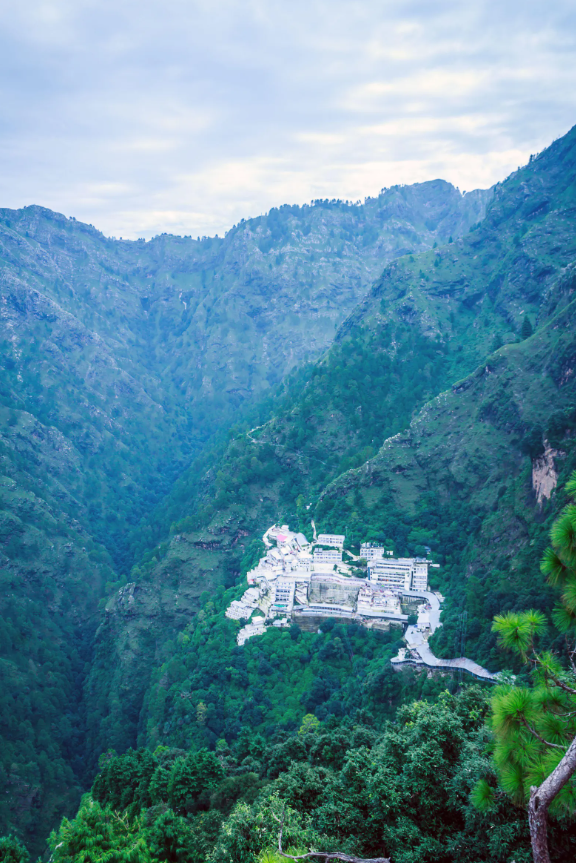The Sacred Journey of Vaishno Devi Yatra and Its Significance in Hindu Mythology
The Origins and Mythological Significance of Vaishno Devi
The Birth of Vaishno Devi
Vaishno Devi, a manifestation of the collective energy of the three powerful goddesses—Maa Kali, Maa Lakshmi, and Maa Saraswati—holds an unparalleled position in Hindu mythology. The legend of her birth begins with the earth being overburdened by the atrocities of demons. Seeing the suffering of the pious, the three goddesses decided to combine their divine energies to create a new, powerful deity who could restore Dharma. Thus, Vaishno Devi was born. Her purpose was to uphold righteousness and protect the devoted.
The story of Vaishno Devi is intrinsically linked with her journey of penance and devotion, culminating in the creation of the sacred shrine that millions of devotees visit today. She represents the essence of purity, devotion, and strength, and her pilgrimage is considered one of the most revered in Hinduism.
The Journey to Trikuta Mountains
The Vaishno Devi shrine is situated in the Trikuta Mountains in the Indian state of Jammu and Kashmir. The journey to this sacred place is known as the
Vaishno Devi Yatra, a pilgrimage that requires immense faith and dedication. According to Hindu mythology, after defeating the demon Bhairavnath, Vaishno Devi took refuge in these mountains, where she meditated and eventually merged into the earth, leaving behind a divine energy in the form of three holy pindis (rock formations). These pindis represent the three goddesses and are the main focus of worship at the shrine.
The Vaishno Devi Yatra is not just a physical journey but a spiritual quest, symbolizing the soul’s journey towards the divine. Pilgrims undertake this journey with the belief that the goddess herself calls them to her abode. The path to the shrine is challenging, often requiring a trek of over 12 kilometers through steep and rugged terrain. Despite the physical challenges, the Yatra is filled with spiritual fervor, with devotees chanting “Jai Mata Di” (Hail the Mother Goddess) as they ascend.
The Sacred Cave and Its Spiritual Significance
The sanctum sanctorum of the Vaishno Devi shrine is a cave where the goddess is believed to have meditated. This cave is considered one of the holiest in Hinduism, symbolizing the womb of the Earth, where the divine energy of the goddess resides. The cave itself is a natural wonder, with the holy pindis emerging from the earth in a mystic and divine manner. Each of the pindis is unique in shape and texture, representing the three forms of the goddess.

Devotees believe that the cave holds immense spiritual power. The journey through the cave represents a passage from the mundane to the divine, where one can leave behind worldly troubles and connect with the goddess on a deeper level. The
spiritual atmosphere of the cave, combined with the natural beauty of the Trikuta Mountains, makes the Yatra a transformative experience for many.
The Rituals and Practices Associated with Vaishno Devi Yatra
The Importance of Purity and Devotion
Before embarking on the Vaishno Devi Yatra, devotees engage in rituals that emphasize purity and devotion. These rituals include fasting, bathing in holy rivers, and offering prayers to the goddess. The Yatra is seen as an act of devotion and self-purification, where pilgrims seek the goddess’s blessings for spiritual and material well-being. The entire journey is marked by a deep sense of devotion, with pilgrims singing hymns, reciting prayers, and performing rituals at various points along the way.
The culmination of the Yatra is the darshan (vision) of the holy pindis, where devotees offer their prayers and seek the goddess’s blessings. The darshan is considered the most auspicious moment of the pilgrimage, where the devotee’s soul is believed to connect with the divine.
The Spiritual Benefits of Vaishno Devi Yatra
Undertaking the
Vaishno Devi Yatra is believed to bring immense spiritual benefits. According to Hindu beliefs, the Yatra cleanses the soul, removes negative energies, and brings the devotee closer to the divine. The goddess is known for fulfilling the wishes of her devotees, and many pilgrims embark on the Yatra with specific prayers in mind, be it for health, prosperity, or spiritual growth.
The Yatra is also considered a form of penance, where the physical hardships of the journey are seen as a way to atone for one’s sins. The spiritual atmosphere of the journey, combined with the collective energy of thousands of pilgrims, creates an environment of divine grace, where miracles are often experienced.

Vaishno Devi in Hindu Mythology and Its Broader Cultural Impact
The Legend of Bhairavnath
The legend of Bhairavnath is a significant part of the Vaishno Devi Yatra. Bhairavnath, a powerful demon, was intent on harming the goddess. After a fierce battle, the goddess beheaded him, but his severed head fell near the entrance of the holy cave. Before dying, Bhairavnath realized the divine nature of Vaishno Devi and begged for forgiveness. The compassionate goddess forgave him and granted him a boon that any devotee visiting her shrine must also visit the Bhairavnath Temple, which is situated a few kilometers away from the main shrine. This ensures that Bhairavnath’s soul attains peace, and the pilgrims receive his blessings as well.
This story highlights the themes of redemption and compassion in Hindu mythology, where even the most sinful beings can attain salvation through the goddess’s grace. The inclusion of the Bhairavnath Temple in the Yatra also emphasizes the importance of humility and forgiveness, teaching devotees the values of compassion and understanding.
Vaishno Devi and the Feminine Divine in Hinduism
Vaishno Devi is revered as a powerful manifestation of the feminine divine in Hinduism. She embodies the strength, wisdom, and nurturing qualities of the goddess, making her a central figure in the worship of Shakti (divine feminine energy). The Vaishno Devi Yatra is a celebration of this
divine feminine power, where devotees, regardless of gender, seek the goddess’s blessings for strength, wisdom, and protection.
In a broader cultural context, the Yatra also symbolizes the empowerment of women, as Vaishno Devi is seen as a role model of strength and independence. The goddess’s story is often invoked in discussions about women’s empowerment and the importance of recognizing the divine feminine in all aspects of life.
Vaishno Devi Yatra and Its Influence on Hindu Pilgrimage Practices
The Vaishno Devi Yatra is one of the most popular and significant pilgrimages in India, attracting millions of devotees each year. Its success has influenced other pilgrimage practices in Hinduism, where the concept of a spiritual journey to a sacred site has become an integral part of religious life. The Yatra is seen as a journey of faith, where the physical act of traveling to the shrine is as important as the spiritual experiences gained along the way.
The pilgrimage has also played a crucial role in the preservation and promotion of Hindu culture and traditions. The rituals, prayers, and hymns associated with the Yatra have been passed down through generations, ensuring that the cultural heritage of Hinduism is preserved and celebrated. The Vaishno Devi Yatra, therefore, is not just a personal spiritual journey but a collective celebration of Hindu identity and faith.
Modern-Day Vaishno Devi Yatra: A Blend of Tradition and Modernity
Infrastructure and Accessibility
In recent years, the Vaishno Devi Yatra has become more accessible, thanks to modern infrastructure and facilities. The government has developed well-maintained pathways, rest houses, and medical facilities along the route to ensure that pilgrims can undertake the journey safely and comfortably. Helicopter services are also available for those who are unable to trek the entire distance, making the Yatra accessible to people of all ages and physical abilities.
Despite these modern developments, the spiritual essence of the Yatra remains unchanged. The devotion and faith of the pilgrims continue to be the driving force behind the pilgrimage, and the journey retains its sacred and transformative nature.
Environmental and Social Impact of Vaishno Devi Yatra
The Vaishno Devi Yatra has a significant impact on the environment and the local communities. The influx of millions of pilgrims each year has led to concerns about environmental degradation, particularly in the fragile ecosystem of the
Trikuta Mountains. However, efforts are being made to promote sustainable practices, such as waste management and the use of eco-friendly materials, to minimize the environmental impact of the Yatra.
Socially, the Yatra has a positive impact on the local economy, providing employment and business opportunities for the residents of the region. The pilgrimage also fosters a sense of community and unity among the devotees, as people from different backgrounds and regions come together to share in the spiritual experience.
 Conclusion: The Eternal Relevance of Vaishno Devi Yatra
Conclusion: The Eternal Relevance of Vaishno Devi Yatra
The Vaishno Devi Yatra is more than just a pilgrimage; it is a journey of faith, devotion, and self-discovery. Rooted in ancient Hindu mythology, the Yatra holds deep spiritual significance for millions of devotees who seek the blessings of the goddess. The
journey to the shrine is symbolic of the soul’s quest for the divine, where the physical challenges of the pilgrimage are overcome by the strength of faith.
In today’s fast-paced world, the Vaishno Devi Yatra continues to be a source of spiritual solace and inspiration. It reminds us of the timeless values of devotion, compassion.
 Devotees believe that the cave holds immense spiritual power. The journey through the cave represents a passage from the mundane to the divine, where one can leave behind worldly troubles and connect with the goddess on a deeper level. The spiritual atmosphere of the cave, combined with the natural beauty of the Trikuta Mountains, makes the Yatra a transformative experience for many.
Devotees believe that the cave holds immense spiritual power. The journey through the cave represents a passage from the mundane to the divine, where one can leave behind worldly troubles and connect with the goddess on a deeper level. The spiritual atmosphere of the cave, combined with the natural beauty of the Trikuta Mountains, makes the Yatra a transformative experience for many.

 Conclusion: The Eternal Relevance of Vaishno Devi Yatra
The Vaishno Devi Yatra is more than just a pilgrimage; it is a journey of faith, devotion, and self-discovery. Rooted in ancient Hindu mythology, the Yatra holds deep spiritual significance for millions of devotees who seek the blessings of the goddess. The journey to the shrine is symbolic of the soul’s quest for the divine, where the physical challenges of the pilgrimage are overcome by the strength of faith.
In today’s fast-paced world, the Vaishno Devi Yatra continues to be a source of spiritual solace and inspiration. It reminds us of the timeless values of devotion, compassion.
Conclusion: The Eternal Relevance of Vaishno Devi Yatra
The Vaishno Devi Yatra is more than just a pilgrimage; it is a journey of faith, devotion, and self-discovery. Rooted in ancient Hindu mythology, the Yatra holds deep spiritual significance for millions of devotees who seek the blessings of the goddess. The journey to the shrine is symbolic of the soul’s quest for the divine, where the physical challenges of the pilgrimage are overcome by the strength of faith.
In today’s fast-paced world, the Vaishno Devi Yatra continues to be a source of spiritual solace and inspiration. It reminds us of the timeless values of devotion, compassion. 